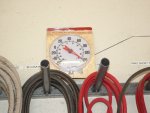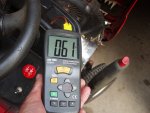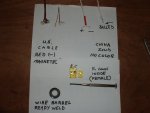WHY WORRY HOW HOT Air cooled heads do not remain at sump oil temperatures. According to experts their heat can rapidly increase and surpass the oil temp when doing hard work (power demand, high ambient temp, lean mixture -and/or combos). Oil coolers do not alleviate this inherent weakness. (There is discussion of oil spray-jets on AC tractor piston bottoms, but seems unlikely IMO due to cost). Most head heat unloads from the head(s) so knowing the danger zone is important, and an idiot lite or reliable index to that heat is key.
IMO the danger zone is 325F to 350F for AC tractor heads. That is based upon "creep" temperature of 390F (Alloy A 242 ) , where head metal starts softening , moving, and cracking-releasing valve guides and seats. AC tractors seem especially vulnerable . They cannot dive/coast (aircraft), or descend/coast (motorcycles) to cool, and lack significant external airblast.
So can the alert owner reduce this temp? IMO he can if he sees it. To see it accurately may be possible with the K thermocouple. Once known, some operational clues (e.g. 80-85F bagging damp grass on hills) or better an accurate warning light , or even stopping for another K couple reading , may avoid problems. Would you rather pull over in shade or tear down your tractor?
IMO the danger zone is 325F to 350F for AC tractor heads. That is based upon "creep" temperature of 390F (Alloy A 242 ) , where head metal starts softening , moving, and cracking-releasing valve guides and seats. AC tractors seem especially vulnerable . They cannot dive/coast (aircraft), or descend/coast (motorcycles) to cool, and lack significant external airblast.
So can the alert owner reduce this temp? IMO he can if he sees it. To see it accurately may be possible with the K thermocouple. Once known, some operational clues (e.g. 80-85F bagging damp grass on hills) or better an accurate warning light , or even stopping for another K couple reading , may avoid problems. Would you rather pull over in shade or tear down your tractor?



